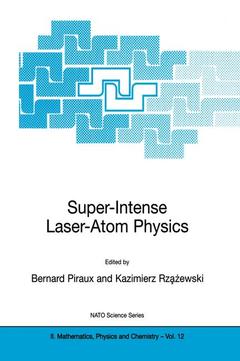Description
Super-Intense Laser-Atom Physics, Softcover reprint of the original 1st ed. 2001
NATO Science Series II: Mathematics, Physics and Chemistry Series, Vol. 12
Coordinators: Piraux Bernard, Rzazewski Kazimierz
Language: English
Subject for Super-Intense Laser-Atom Physics:
Super-intense laser-atom physics
Publication date: 03-2001
416 p. · 16x24 cm · Hardback
Publication date: 03-2001
416 p. · 16x24 cm · Hardback
Super-intense laser-atom physics
Publication date: 03-2001
416 p. · 17x24.4 cm · Paperback
Publication date: 03-2001
416 p. · 17x24.4 cm · Paperback
Description
/li>Contents
/li>
The study of atomic systems exposed to super-intense laser fields de fines an important area in atomic, molecular and optical physics. Although the concept of super-intense field has no absolute meaning, it is now usual to call an electromagnetic field super-intense when it exceeds the atomic binding field. In the case of the simplest atomic system, hydrogen in its 16 2 ground state, this occurs above an intensity of 3. 5 x 10 Wattfcm which is the atomic unit of intensity. Presently at the laboratory scale and in ex tremely short and tightly focussed laser pulses, the electric field strength 16 18 2 reaches peak values which are of the order of 10 - 10 Wattfcm in the infrared frequency regime, the prospect being that such peak intensities may be reached within a few years in a regime of much higher frequencies (XUV or even X). The interaction of such electromagnetic fields with an atomic system has a highly non-linear character which has led to the observation of to tally unexpected phenomena. There are three fundamental processes which have marked the beginning of an intensive research in the field of super intense laser-atom physics (SILAP). These processes which only involve one atomic electron are (i) the so-called above-threshold ionisation i. e.
Energy distribution of two-electron ionization of helium in an intense laser field.- Double ionization in strong fields: ion momenta and correlated electron momenta.- Mechanism of the nonsequential double ionization of helium.- Electron momentum distributions for double ionization in the strong field limit.- S-matrix theory of ‘recoil-ion’ momentum distribution for double ionization in femtosecond laser fields.- Nonsequential double ionization: a minimal correlation approach.- Non-sequential double ionization of atoms in strong fields.- Double-electron ionization of two-electron system in a strong laser field.- Calculation of double ionization of helium.- The two-electron response in laser driven helium.- The helium atom in strong and short laser pulses: Multielectron effects.- Dynamics of a two-electron system driven by an ultrashort and intense laser pulse.- Angular distributions for double ionization by an ultrashort, intense laser pulse: the case of Li-.- Two-and three electron atoms in strong laser fields.- Tunnelling ionization and the Franck-Condon principle.- Dissociative ionization of few-electron molecules in intense laser fields.- One-photon breakup of H2+ in a strong DC field.- Nuclear fusion in gases of deuterium clusters and hot electron generation in droplet sprays under irradiation with an intense femtosecond laser.- The absorption of energy by large atomic clusters from superintense laser pulses.- A semi-classical model for high-harmonic generation.- Beyond the simple man’s model for high harmonic generation.- Anisotropy-induced polarization effects in harmonic generation by an absorptive medium.- About new method of high harmonic amplification.- X-ray generation via stimulated recombination of electrons and Bohr’s correspondence principle.-Interference stabilization: ?- and V-schemes, dynamics of ionization initial coherent population of Rydberg levels and quantum phase control of the ionization yield.- Computer experiments on atomic stabilization in a strong laser field.- Quasistationary stabilization of the decay of a weakly-bound level and its breakdown in a strong laser field.- The strong field limit of atomic stabilization in ultrashort pulses.- 3-D numerical calculations of laser atom interactions — Subrelativistic and weakly relavistic regime.- Momentum space description of hydrogen atom interacting with a low frequency, strong laser field.- Relativistic effects in the atomic response to super-intense laser pulses.- Weakly relativistic stabilization — The effect of the magnetic field.- Intense laser-atom interactions: beyond the dipole approximation.- A picturebook of relativistically driven wavepackets.- Position dependent tunneling speed for particles under a barrier.- Relativistic energy and angular distributions of electrons in the ionization of atoms by super-intense laser radiation.- Atomic wave packets created by short electric pulses.- Strong field coherent control.- Author Index.
© 2024 LAVOISIER S.A.S.




